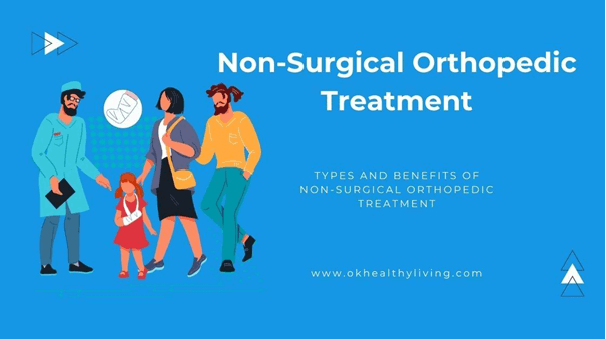As the world becomes more and more competitive, people are looking for ways to stay ahead of the curve. One way to do this is by undergoing non-surgical orthopedic treatments. Orthopedic treatments are designed to improve the function and quality of life of people who have suffered from injuries or conditions in their musculoskeletal system.
Some common types of orthopedic treatments include: exercises, physical therapy, and surgery. Non-surgical orthopedic treatments have a number of benefits that make them stand out from other types of orthopedic treatments.
In this article, we will talk about different types of non-surgical orthopedic treatments and their proven benefits.

Different Types of Non-Surgical Orthopedic Treatments
Non-surgical orthopedic treatments include physical therapy, exercises, and surgery. What kind of non-surgical therapy you will need depends on your physical situation. Before you start treating non-surgical treatments, you have to ensure that you are picking the right one. You can take help from professionals like Atlanta Innovative Medicine (Atlanta Innovative Medicine is a popular non-surgical treatment center located in Georgia) to choose the right therapy for your disease. Now, let’s get ideas about different non-surgical treatments.
Physical therapy is one of the most common types of non-surgical orthopedic treatments. Physical therapy involves a combination of physical activities and treatment to improve the function of injured tissues and muscles. An example of a physical therapy treatment is massage. A massage therapist uses their hands to apply gentle pressure on specific areas in order for the client to stimulate blood flow to the area which may have been affected by injury or disease, thus improving the function and quality of life for the client.
Exercises are another popular type of non-surgical orthopedic treatments used by people who have suffered from injuries or conditions in their musculoskeletal system. Exercises are designed to improve the function and quality of life for clients who have suffered from injuries or conditions in their musculoskeletal system by working on muscles which may be weakened due to injury or disease, thus helping them regain the function and quality of life they once had. Examples of exercises include: stretching, weight lifting, and cardio exercises. Click here to read our latest articles about exercises to relief muscle pain.
Surgery is another type of non-surgical orthopedic treatments used by people who have suffered from injuries or conditions in their musculoskeletal system. Surgery is a procedure which involves the use of surgery to improve the function and quality of life for clients who have suffered from injuries or conditions in their musculoskeletal system by removing damaged tissues, repairing damaged tissues, or replacing damaged tissues. An example of a surgery treatment would be an arthroscopic procedure performed by a surgeon to remove damaged tissue from the knee joint area.
Common conditions that can be treated without surgery
According to the American Academy of Orthopedic Surgeons (AAOS), there are many conditions that can be treated without surgery. Some of these conditions include: headaches, neck pain, back pain, and more. By understanding the symptoms and seeking out appropriate treatment, you can often avoid surgery altogether.
Some of the most common conditions that can be treated without surgery include headaches, neck pain, back pain, carpal tunnel syndrome, and whiplash. To avoid surgery in these cases, it is important to identify the source of the pain and treat it accordingly. For example, if you have a headache, try drinking plenty of fluids and taking headache medication. If the pain is coming from the neck, try applying heat or massage to the area. For back pain, try resting and exercising regularly. Carpal tunnel syndrome can be treated with physical therapy and/or surgery. Whiplash can be treated with rest, ice packs, and analgesics.
Benefits of Non-Surgical Orthopedic Treatments
Non-surgical orthopedic treatments offer numerous benefits for those who are looking to improve their health and quality of life. For example, surgical orthopedic treatments can be costly, time-consuming, and require a lot of recovery time. Non-surgical orthopedic treatments, on the other hand, tend to be less invasive and require less time to recover.
Non-surgical orthopedic treatments are generally safe and effective, and they can help people to improve their quality of life. They can also help to restore mobility and reduce the risk of chronic pain. If you are suffering from pain and discomfort, it is important to speak to your doctor about the possibility of using non-surgical orthopedic treatments.
Additionally, non-surgical orthopedic treatments often offer better results than surgical orthopedic treatments. This is because surgical orthopedic treatments rely on surgery to fix a problem, while non-surgical treatments often rely on other methods such as physical therapy, injections, or braces.
Some of the other benefits of non-surgical orthopedic treatments include increased range of motion, improved joint stability, and reduced pain. All of these benefits can lead to an improved quality of life and reduced dependence on medications or surgery.
Conclusion
Non-surgical orthopedic treatments offer a number of benefits over surgical procedures. They are often less invasive, require less recovery time, and are typically more affordable. If you are experiencing pain or discomfort in your bones or joints, it is worth exploring the many non-surgical treatment options available to you. Non-surgical orthopedic treatments are a viable option for many conditions and offer numerous benefits. If you are considering this type of treatment, be sure to consult with a physician who specializes in orthopedics to get the best results.
